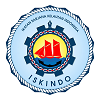Distribusi Kelimpahan dan Pola Pertumbuhan Kepiting Bakau (Scylla spp.) di Kawasan Mangrove Golo Sepang, Nusa Tenggara Timur
Abstract
ABSTRACT
Kepiting bakau (Scylla spp.) merupakan salah satu komoditas sumberdaya perikanan yang potensial untuk dikembangkan karena memiliki nilai ekonomis yang tinggi. Kawasan mangrove di Golo Sepang merupakan penghasil kepiting bakau terbesar di Kabupaten Manggarai Barat, Nusa Tenggara Timur. Penelitian ini dilakukan untuk menganalisis distribusi dan pola pertumbuhan kepiting bakau (Scylla spp.) di perairan Golo Sepang, Nusa Tenggara Timur. Sampel kepiting bakau diambil pada bulan Maret–Mei 2022 di lokasi yang biasa digunakan nelayan untuk menangkap kepiting bakau dengan menggunakan alat tangkap bubu lipat. Terdapat tiga spesies kepiting bakau dari total 870 individu yang diukur, yaitu S. serrata, S. paramamosain, dan S. olivicea. Sebaran kelimpahan kepiting bakau lebih banyak terdapat di area yang suhu dan salinitasnya lebih tinggi. Pertumbuhan kepiting bakau jenis S. serrata di lokasi penelitian memiliki pola isometrik sedangkan S. paramamosain dan S. olivacea memiliki pola alometrik positif. Pertumbuhan kepiting jantan lebih cepat dan lebih besar daripada pertumbuhan kepiting betina.
Kata kunci: Distribusi, kepiting bakau, mangrove, pertumbuhan, salinitas
ABSTRACT
Mud crab (Scylla spp.) is one of the potential fishery commodities to be developed due to its high economic value. The mangrove area in Golo Sepang Waters is the largest producer of mangrove crabs in West Manggarai, East Nusa Tenggara. This study was conducted to analyze the distribution and growth pattern of mud crabs (Scylla spp.) in Golo Sepang, East Nusa Tenggara. Mud crab samples were captured in March – May 2022 at the sites regularly used by fishermen to catch the crabs using folded traps (bubu). A total of 870 measured samples consisting of three species of mud crabs: S. serrata, S. paramamosain, and S. olivicea. The distribution pattern of mud crabs at the study location as per salinity and temperature patterns. The growth of S. serrata at the study site had an isometric pattern while S. paramamosain and S. olivacea had a positive allometric pattern. The growth of male crabs is faster and bigger than the growth of female crabs.
Keywords: Distribution, mud crab, mangrove, growth, salinity
Full Text:
PDF (Bahasa Indonesia)References
Bir, J., Islam, S. S., Sabbir, W., Islam, M. R., & Huq, K. A. (2020). Ecology and reproductive biology of Mud Crab Scylla spp: A study of commercial mud crab in Bangladesh. International Journal of Academic Research and Development, 5(2), 1–7.
Courtney, Y., Courtney, J., & Courtney, M. (2014). Improving Weight-Length Relationships in Fish to Provide More Accurate Bioindicators of Ecosystem Condition. Aquatic Science and Technology, 2(2), 41. https://doi.org/10.5296/ast.v2i2.5666
Fazhan, H., Waiho, K., Al-Hafiz, I., Kasan, N. A., Ishak, S. D., Afiqah-Aleng, N., Tola, S., & Ikhwanuddin, M. (2021). Composition, size distribution, length-weight relationship of sympatric mud crab species (Scylla) and the case of presumed hybrids. Estuarine, Coastal and Shelf Science, 250(December 2020), 107154. https://doi.org/10.1016/j.ecss.2020.107154
Government of Western Australia. (2013). Fisheries Fact Sheet: Mud Crab. Department of Fisheries, March, 1–4.
Hastuti, Y. P., Affandi, R., Millaty, R., Tridesianti, S., & Nurussalam, W. (2019). Suhu terbaik untuk meningkatkan pertumbuhan dan kelangsungan hidup benih kepiting bakau Scylla serrata di sistem resirkulasi. Jurnal Ilmu Dan Teknologi Kelautan Tropis, 11(2), 311–322. https://doi.org/10.29244/jitkt.v11i2.22727
Hastuti, Y. P., Nirmala, K., Suryani, I., & Prasetiyo, S. L. (2019). Environmental characteristics of mangrove forest as a reference for development of mud Crab Scylla serrata cultivation: A case study in Mojo Village, Ulujami, Pemalang. IOP Conference Series: Earth and Environmental Science, 278(1), 012035. https://doi.org/10.1088/1755-1315/278/1/012035
Hidayatullah, M., & Pujiono, E. (2014). Struktur Dan Komposisi Jenis Hutan Mangrove Di Golo Sepang – Kecamatan Boleng Kabupaten Manggarai Barat. Jurnal Penelitian Kehutanan Wallacea, 3(2), 151. https://doi.org/10.18330/jwallacea.2014.vol3iss2pp151-162
Hill, B. J. (1975). Abundance, breeding and growth of the crab Scylla serrata in two South African estuaries. Marine Biology, 32(2), 119–126. https://doi.org/10.1007/BF00388505
Iromo, H. (2019). Pengembangan Budi Daya Kepiting Bakau di Kaltara. Deepublish Publisher.
Kasry, A. (1991). Budidaya Kepiting Bakau dan Biologi Ringkas. Bhratara.
Keenan, C. P., Davie, P. J. F., & Mann, D. L. (1998). A revision of the genus Scylla de Haan, 1833 (Crustacea: Decapoda: Brachyura: Portunidae). Raffles Bulletin of Zoology, 46(1), 217–245.
Peraturan Menteri Kelautan Dan Perikanan Republik Indonesia Nomor 17 Tahun 2021, Peraturan Menteri Kelautan dan Perikanan Republik Indonesia Nomor 17 Tahun 2021 (2021).
Mohd Sharif, N. A., Shaiful Kahar, N. A., Syed Hussein, M. A., Ransangan, J., & Yong, A. S.-K. (2019). Species diversity and distribution of mud crab in Marudu Bay mangrove forest reserve, Sabah, Malaysia. Borneo Journal of Marine Science and Aquaculture (BJoMSA), 3(1), 18–24. https://doi.org/10.51200/bjomsa.v3i1.1709
Oktamalia, O., Apriyanto, E., & Hartono, D. (2019). Potensi Kepiting Bakau (Scylla Spp) Pada Ekosistem Mangrove Di Kota Bengkulu. Naturalis: Jurnal Penelitian Pengelolaan Sumber Daya Alam Dan Lingkungan, 7(1), 1–9. https://doi.org/10.31186/naturalis.7.1.9253
Pratiwi, R., Sukardjo, S., Widyastuti, E., & Hafizt, M. (2022). An ecological study and its fishery potential of the mud crab, Scylla serrata (Forskål, 1775) in Segara Anakan mangrove waters, Cilacap, Indonesia. Jurnal Pengelolaan Sumberdaya Alam Dan Lingkungan (Journal of Natural Resources and Environmental Management), 12(3), 404–413. https://doi.org/10.29244/jpsl.12.3.404-413
Rouf, M. A., Istiak, S. I. M., Antu, A., & Siddiqui, N. M. (2021). Population parameters of the orange mud crab Scylla olivacea (Herbst , 1796) from the Sundarban mangrove forest in Bangladesh. Heliyon, 7(2), e06223. https://doi.org/10.1016/j.heliyon.2021.e06223
Sara, L., Aguilar, R. O., Ingles, J. A., & Laureta, L. V. (2014). Habitat characteristics and relative abundance of the mud crab Scylla serrata (Forskål , 1775) in Lawele Bay , Southeast Sulawesi , Indonesia. Ege J Fish Aqua Sci, 31(1), 11–18. https://doi.org/10.12714/egejfas.2014.31.1.03
Sara, L., Ingles, J. A., Baldevarona, R. B., Aguilar, R. O., Laureta, L. V., & Watanabe, S. (2002). The natural diet of the mud crab (Scylla serrata) in Lawele bay , Southeast Sulawesi , Indonesia Reproductive Biology of Mud Crab Scylla serrata in Lawele Bay ,. Crustacean Fisheries 2002:, 88–95.
Shahriar, M. S. I., & Rouf, M. A. (2018). International Journal of Fisheries and Aquatic Studies 2018; 6(4): 451-455 Sex ratio, length-weight relationship, condition and relative condition factor of mud crab (Scylla olivacea) in Sunderban mangrove forest, Bangladesh. International Journal Of Fisheries and Aquatic Studies, 6(4), 451–455. www.fisheriesjournal.com
Shaiful Kahar, N. A., Yong, A. S. K., Mohd Sharif, N. A., Syed Hussein, M. A., & Ransangan, J. (2022). Reproductive cycle and size at maturity of wild mud crab, Scylla tranquebarica(Fabricus, 1798) in Marudu Bay, Sabah. Borneo Journal of Marine Science and Aquaculture (BJoMSA), 6(1), 20–29. https://doi.org/10.51200/bjomsa.v6i1.1543
Shelley, C., & Lovatelli, A. (2011). Mud Crab Aquaculture. In Recent Advances and New Species in Aquaculture. Food and Agriculture Organization of the United Nations. https://doi.org/10.1002/9781444341775.ch4
Sihsubekti, S., & Fidhiani, D. D. (2021). Identifikasi nilai sikap masyarakat terhadap pengembangan potensi budidaya kepiting bakau (Scylla serrata) di desa Sumberwaru kecamatan Banyuputih kabupaten Situbondo. Agromix, 12(1), 47–54. https://doi.org/10.35891/agx.v12i1.2429
Sunarto, ., Sulistiono, ., & Setyobudiandi, I. (2016). Hubungan jenis kepiting bakau (Scylla spp.) dengan mangrove dan substrat di tambak silvofishery Eretan, Indramayu (Relationship of Mudcrab (Scylla Spp.) with Mangrove and Substrate in Silvofishery Ponds, Eretan, Indramayu). Marine Fisheries : Journal of Marine Fisheries Technology and Management, 6(1), 59–68. https://doi.org/10.29244/jmf.6.1.59-68
Suryandari, A., Maharsari, A. P., Irawan, B., & Soegianto, A. (2018). Length-weight relationship, sex ratio and condition factors of mud crab (Scylla paramamosain Estampador, 1949) from Brantas Estuary, East Java, Indonesia. AIP Conference Proceedings, 2002(1), 20007. https://doi.org/10.1063/1.5050103
Waiho, K., Mustaqim, M., Fazhan, H., Wan Norfaizza, W. I., Megat, F. H., & Ikhwanuddin, M. (2015). Mating behaviour of the orange mud crab, Scylla olivacea: The effect of sex ratio and stocking density on mating success. Aquaculture Reports, 2, 50–57. https://doi.org/10.1016/j.aqrep.2015.08.004
Ward, T. M., Schmarr, D. W., & McGarvey, R. (2007). Northern Territory Mud Crab Fishery : 2007 Stock Assessment. Report to Northern Territory Department of Primary Industries and Mines. In NSW Department of Primary Industries.
Widigdo, B., Rukisah, Laga, A., Hakim, A. A., & Wardiatno, Y. (2017). Carapace length-weight and width-weight relationships of Scylla serrata in Bulungan District, North Kalimantan, Indonesia. Biodiversitas, 18(4), 1316–1323. https://doi.org/10.13057/biodiv/d180405
Widria, Y. (2019). Prospek Pasar Ekspor Rajungan dan Kepiting Indonesia ke China. https://kkp.go.id/djpdspkp/page/2202-realisasi-investasi-sektor-kelautan-dan-perikanan
Wijaya, N. I., Yulianda, F., Boer, M., & Juwana, S. (2010). Biologi populasi kepiting bakau (Scylla serrata F.) di habitat mangrove taman nasional Kutai Kabupaten Kutai Timur. Oseanologi Dan Limnologi Di Indonesia, 36(3), 443–461.
Zhang, D. (2017). A Coefficient of Determination for Generalized Linear Models. American Statistician, 71(4), 310–316. https://doi.org/10.1080/00031305.2016.1256839.
DOI: https://doi.org/10.21107/jk.v16i3.23128
Refbacks
- There are currently no refbacks.

This work is licensed under a Creative Commons Attribution 4.0 International License.

Jurnal Kelautan by Program Studi Ilmu Kelautan is licensed under a Creative Commons Attribution 4.0 International License.
Published by: Department of Marine Sciences, Trunojoyo University of Madura













